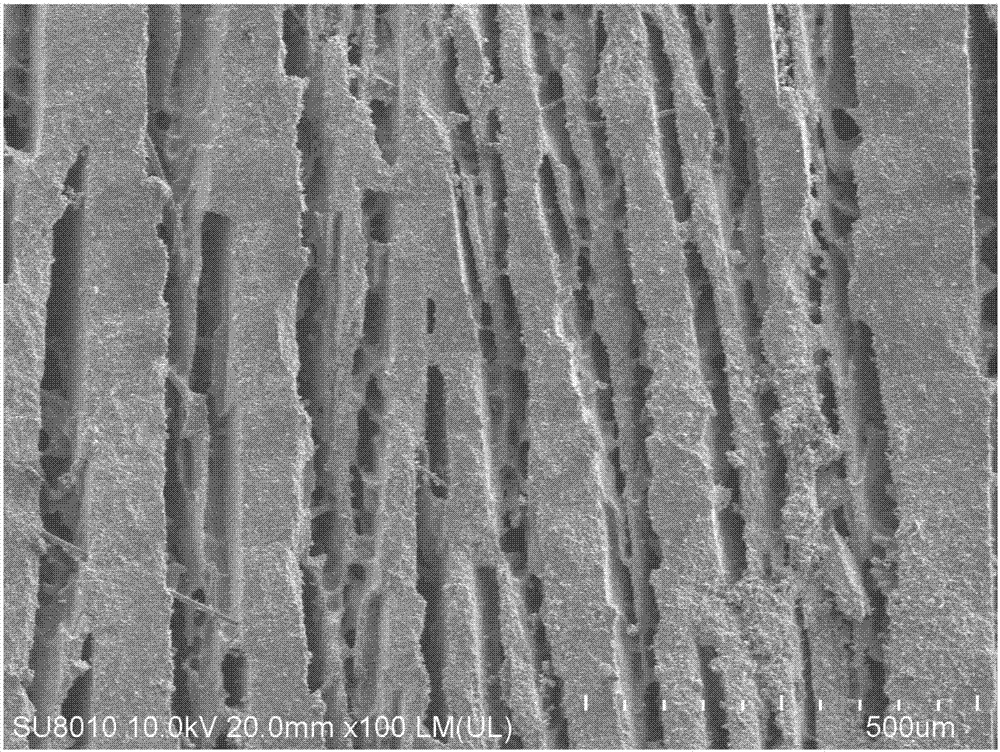Manufacturing method ceramic-based composite part with three-stage pores
A composite material and manufacturing method technology, applied in the field of ceramic parts manufacturing, can solve the problems of poor uniformity of pore distribution and inability to manufacture pores with small pore diameters, and achieve the effects of good uniformity, good surface quality and high specific surface area
- Summary
- Abstract
- Description
- Claims
- Application Information
AI Technical Summary
Problems solved by technology
Method used
Image
Examples
Embodiment 1
[0056] 1) Use UG 3D modeling software to design the 3D model of the part, and output the STL file. Use the rapid prototyping post-processing software Magics to add the necessary support structure to the model, and slice and layer. Import the processed data files into the shell of the parts manufactured by the SPS600B photocuring molding equipment. The molding process parameters are set as follows: UV beam power is 250mW, filling scanning speed is 4500.00mm / s, filling vector spacing is 0.10mm, supporting scanning speed is 1200.00mm / s, jumping speed is 1200.00mm / s, contour scanning speed is 4000.00mm / s, The layer thickness is 70-100μm, the spot compensation diameter is 150μm, and the lifting speed of the worktable is 3.00mm / s. After processing, clean with industrial alcohol to remove the liquid residual resin material on the surface and remove the support, put it into an ultraviolet curing box for further curing, and obtain a resin mold with a layered structure inside.
[0057...
Embodiment 2
[0065] 1) Use UG 3D modeling software to design the 3D model of the part, and then make the resin shell of the part through SLA light curing molding technology.
[0066] 2) Mix the organic monomer (acrylamide AM) and the crosslinking agent (N,N'-methylenebisacrylamide MBAM) at a mass ratio of 5:1, and then dissolve it at room temperature (25°C) to deionized In water, a water-based premix solution with a mass fraction of 15% is prepared. Slowly add the mixed powder of micron-sized silicon nitride and boron carbide and carbon fiber into the dispersed water-based premix to obtain a ceramic slurry with a solid content of 10%. The amount of carbon fiber added accounts for 5%, and then add an aqueous solution of tetramethylammonium hydroxide with a mass fraction of 25% as a dispersant, and the amount of the dispersant added is 1.5% of the total mass of the ceramic powder to obtain a premixed slurry. Then put the premixed slurry into a mechanical stirrer and stir for 30 minutes to f...
Embodiment 3
[0073] 1) Use UG 3D modeling software to design the 3D model of the part, and then make the resin shell of the part through SLA light curing molding technology.
[0074]2) Mix the organic monomer (acrylamide AM) and the cross-linking agent (N,N'-methylenebisacrylamide MBAM) at a mass ratio of 25:1, and then dissolve it at room temperature (25°C) to deionized In water, it is prepared into a water-based premix with a mass fraction of 25%. Slowly add micron-sized zirconium boride and carbon fiber mixed powder into the dispersed water-based premix to obtain a ceramic slurry with a solid content of 45%. The amount of carbon fiber added accounts for 25% of the total mass of the slurry, and then the mass fraction is A 25% aqueous solution of tetramethylammonium hydroxide was used as a dispersant, and the amount of the dispersant added was 2% of the total mass of the ceramic powder to obtain a premixed slurry. Then put the premixed slurry into a mechanical stirrer and stir for 10 min...
PUM
| Property | Measurement | Unit |
|---|---|---|
| Particle size | aaaaa | aaaaa |
Abstract
Description
Claims
Application Information
 Login to View More
Login to View More - Generate Ideas
- Intellectual Property
- Life Sciences
- Materials
- Tech Scout
- Unparalleled Data Quality
- Higher Quality Content
- 60% Fewer Hallucinations
Browse by: Latest US Patents, China's latest patents, Technical Efficacy Thesaurus, Application Domain, Technology Topic, Popular Technical Reports.
© 2025 PatSnap. All rights reserved.Legal|Privacy policy|Modern Slavery Act Transparency Statement|Sitemap|About US| Contact US: help@patsnap.com

